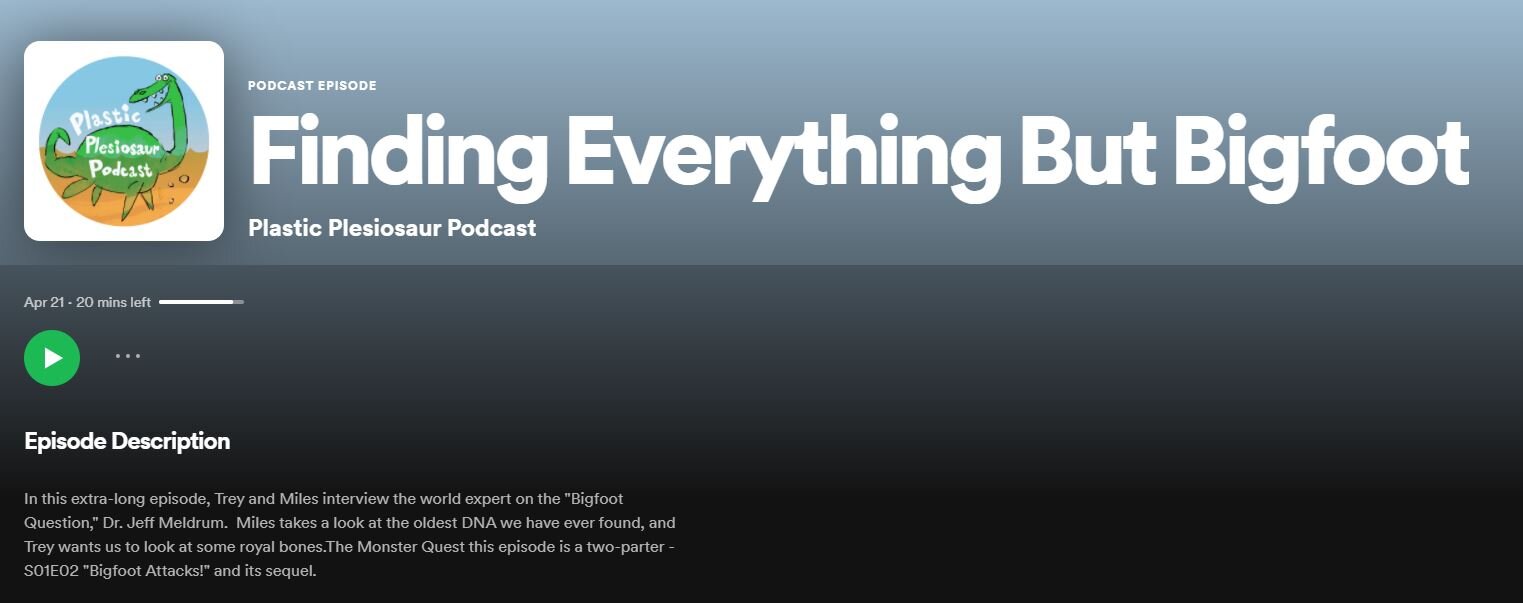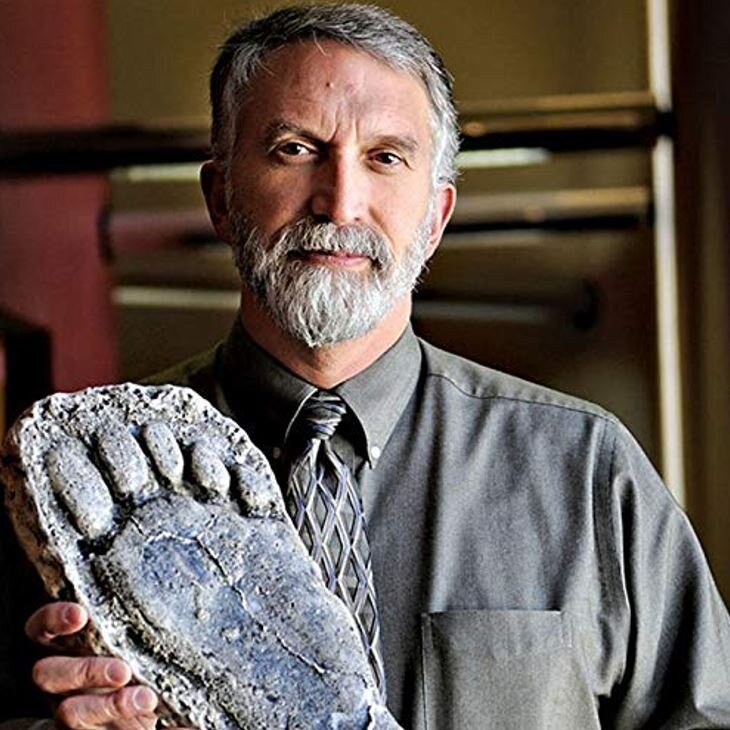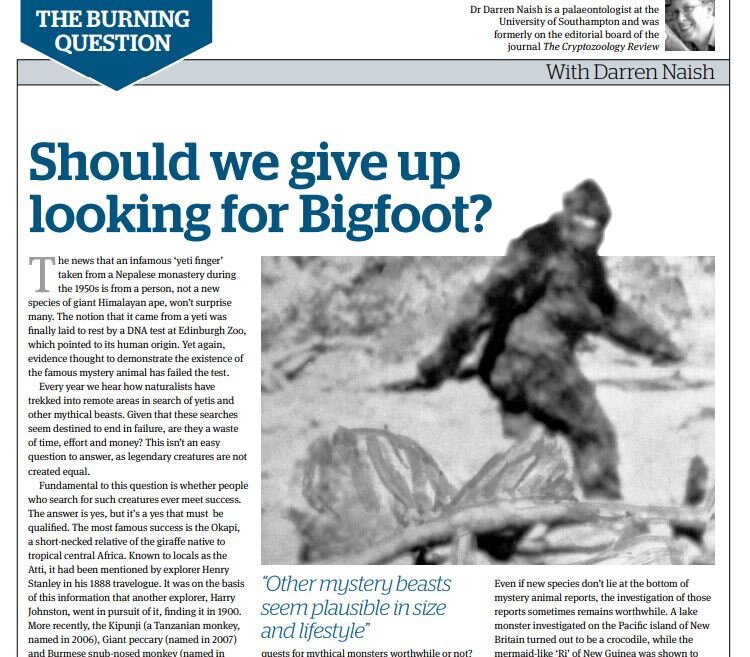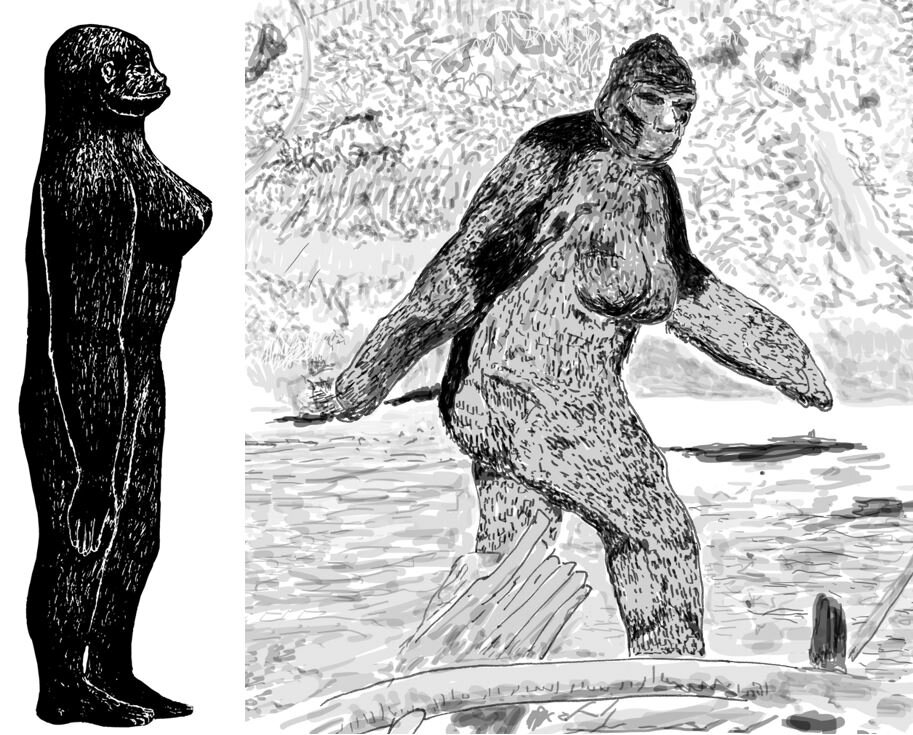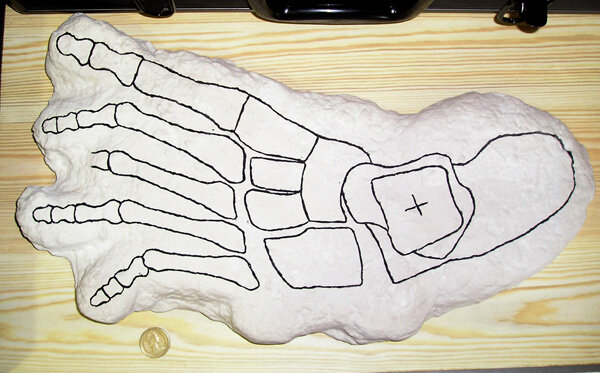Oh bigfoot… I want to believe…
I keep promising myself to avoid cryptozoological topics here, since I feel like I’ve covered them a fair bit over recent months. But the fact that I have a major cryptozoology-themed project going on in the background (all to be revealed, in time) means that the subject is, alas, on my mind.
Over the last few days, Trey the Explainer and Miles Greb have released – at their Plastic Plesiosaur Podcast – a lengthy and very interesting episode in which they interview Dr Jeff Meldrum. As you’ll surely know if you’re at all familiar with modern cryptozoological research, Dr Meldrum is widely regarded as one of the primary – if not the primary – advocate of the idea that bigfoot is real and is an undiscovered hominid*, likely part of the pongine lineage. What makes Meldrum unusual in his advocacy of this position is that he’s also a qualified scientist, and specifically a primatologist whose specific area of research is functional morphology, locomotion and limb anatomy (e.g., MacPhee & Meldrum 2006, Lu et al. 2011, Meldrum 1993, 2004, Meldrum et al. 1990, 1992, Sarmiento & Meldrum 2011). Whatever his biases and history of exposure to the bigfoot phenomenon are, the fact remains that Meldrum’s opinion on the evidence, such as it is, carries a reasonable amount of ‘weight’ relative to that of many other people who profess an opinion on bigfoot, certainly so if – like me – you’re a qualified academic too. My apologies if that sounds odd or elitist: it shouldn’t; it’s a reflection of fair respect for appropriate and demonstrated expertise, something which is elsewhere generally absent in cryptozoology.
Caption: Dr Jeff Meldrum, primatologist, professor of anatomy and anthropology, and bigfoot proponent.
* I’ve noticed that Meldrum tends to use ‘traditional’ taxonomic terms when discussing bigfoot and other crypto-hominids, typically restricting the term ‘hominid’ to the human lineage and using the term ‘hominoid’ when discussing all great apes. This isn’t consistent with majority usage among technical specialists: the term hominoid refers to the entire ape clade (gibbons, a list of extinct groups, and great apes and humans), and the term hominid refers to the great ape clade (which includes pongines and hominines). Members of the human clade are vernacularly termed hominins. In case things are unclear, I know that Meldrum is aware of this as he uses the more ‘technical’ taxonomic preferences in his academic works.
First of all, I like Jeff Meldrum, I like the fact that he’s pushing the need for research into bigfoot as a biological phenomenon, and I appreciate that he’s willing to engage with honest scepticism on the topic, even though I disagree with him on various points. His research continues the tradition (if we can call it that) established previously by Grover Krantz and John Bindernagel, both of whom also held relevant academic qualifications and, like Meldrum, published work supporting the existence of bigfoot as a real undiscovered primate (e.g., Bindernagel 1998, Krantz 1999, Meldrum 2006). Neither are with us anymore.
Preamble out of the way, let’s move on to the various points of the interview I want to comment on.
On Publishing Results. Meldrum’s primary argument for advocation of the ‘biological bigfoot’ is that we have so much more than eyewitness data: there’s tracks, hairs and more. Miles and Trey asked quite a lot about the provenance of this data and why it hasn’t been published, and an issue returned to more than once in the interview is the difficulty Meldrum has in getting his bigfoot work into the mainstream literature.
For those not familiar with the publication of technical research, it should be noted that it’s often hard to get ‘mainstream’ scientific results of any sort into the literature: the peer-review system is tough, even brutal, and very often unfair and even dysfunctional. We all have horror stories. Given that compelling biological evidence for the existence of bigfoot still has yet to be presented, it isn’t surprising that most publications and most reviewers will reject any relevant manuscripts off the bat (good luck even getting things to review stage).
I’m in full agreement with the interviewers (and not with Meldrum), then, that the difficulty he faces and has faced is therefore a reflection of the persisting lack of good evidence: what’s been presented so far, what exists so far, still doesn’t cut it. Which – if the ‘biological bigfoot’ exists – is problematic. I’m all for continued testing and searching and collecting, but an editor or reviewer right now would be correct in rejecting the premise that the biological bigfoot exists. In short, there’s a good reason for the general ‘rejectionist’ attitude toward the phenomenon that exists within the technical zoological community.
Caption: is the evidence put forward for bigfoot so bad that we should give up? Whatever you think of my specific intellectual position, my repeated revisiting of the phenomenon shows that I consider it a worthy area of research. But I understand the position of those colleagues who don’t see a reason for us to be all that interested. This is a partial screengrab from a 2012 article of mine.
DNA and eDNA, Bigfoot’s Tale and Nessie’s Too. On the subject of the community’s approach to technical studies on bigfoot-related data, I want to note in passing that the claim – made often in the bigfoot community (albeit not necessarily in the relevant interview) – that the infamous Ketchum et al. (2013) study was repeatedly rejected by journals through sheer cowardice and disinterest is utterly incorrect. I can state this with confidence because I was a reviewer of the paper at two different top-tier journals. The paper was repeatedly rejected because it had clear methodological and other issues.
And having mentioned DNA, also covered in the interview was some discussion of the Sykes et al. (2014) study. As is now well known, the point regarded by journalists and the public as the main takehome from this study – that the yeti was shown to be a bear, ostensibly a ‘new’ bear representing a hitherto unrecognised polar x brown bear hybrid – was fatally flawed, as demonstrated by two follow-up studies (Edwards & Barnett 2015, Gutiérrez & Pine 2015). The Sykes et al. (2014) team apparently made the mistake they did because they misrecorded the labelling of a genetic sample obtained from genbank – a schoolboy error! I think that Miles and Trey, and Dr Meldrum, all aimed to make this point in the interview but they got sidetracked once or twice and hence failed to emphasise it.
Incidentally, I met Brian Sykes during the data-collection phase of that project and have my own take on what happened. I’m not entirely convinced that it was an honest effort to investigate the crypto-hominid phenomenon. Instead, it was an effort to publish a technical paper linked to a TV series.
Caption: the Sykes et al. (2014) study is linked to a successful (and very watchable) TV series. I don’t know how widely known this is. I was involved at one stage in a follow-up series concentrating on a different set of cryptozoological stories….
Finally on DNA, the interview also included discussion of the now famous Loch Ness eDNA study led by Professor Neil Gemmell. A technical paper stemming from this study has (I can confirm following personal communication with Professor Gemmell) not yet been published, but I want to state that Meldrum appears to have misunderstood the study’s results… which is not his fault. The study has not done anything like demonstrate that Nessie might be a giant eel. What is has instead done is show (to some reasonable degree of satisfaction) that virtually all contending hypotheses for the identification of the Loch Ness Monster can be excluded, excepting the eel hypothesis. In other words; the eDNA data doesn’t rule out the eel idea (because it found copious evidence for eels in the loch), but this is nothing like the same as saying that Nessie is (a) real and (b) can only, or best, be explained by sightings of giant eels of a hypothetical sort. I should add at this point that I know, and have spent some time with, those researchers who’ve advocated the giant eel hypothesis. They’ve based it on logical inference and a few dodgy eyewitness accounts.
Caption: is Loch Ness (at right) home to EELS? YES. Is the Loch Ness Monster (a) a real and novel biological entity and (b) actually demonstrated by eDNA to BE AN EEL? Nope. At left, your humble author with Prof Neil Gemmell.
Some Key Accounts. Moving now back to bigfoot, the interview touched several times on various of the foundational accounts and observations that are key to the view of bigfoot promoted by Meldrum and others.
But, alas, some of the key historical events are now so tainted that they can’t simply be repeated or accepted as support for bigfoot. As was covered in the interview, the William Roe story is problematic, and the Patterson-Gimlin footage seemingly exists due to Patterson’s familiarity with the Roe story (as is discussed in several sceptical texts on bigfoot: Conway et al. 2013, Loxton & Prothero 2013, Naish 2017). The Ape Canyon story is more problematic than noted in the interview, as there’s a recently unearthed story about the whole event being the product of a prank played by a group of young men who spent the evening throwing stones and such at the cabin. It’s not difficult to imagine how this could have caused an escalating level of fear about unseen assailants.
Caption: classic bigfoot accounts and sightings - like the William Roe story of the late 1950s and the filmed Patterson-Gimlin encounter - have baggage and it might be wrong to accept them at face value. Images: John Conway; Darren Naish.
Is the eyewitness evidence for bigfoot compelling? That’s kinda subjective but I’m inclined to say that it’s very very suggestive. What I’ve tried to make clear in recent articles (e.g., my 2016 If Bigfoot Were Real at TetZoo ver 3) is that – no matter how compelling it is – we have a real problem in that other lines of evidence are either absent or highly problematic.
The Track Evidence. So, Meldrum leans very heavily on the tracks and on his ability to identify specific anatomical traits which demonstrate (1) authenticity and (2) non-human nature. I appreciate the value of cataloguing the anatomy he observes in the tracks; the concern (as stated in my book Hunting Monsters) is that confident pronouncements of track reality have been made in the past (specifically by Grover Krantz) and yet have then come undone when the ‘gold standard’ tracks were seemingly outed as very good hoaxes. And some of the key bits of anatomy concerned (like dermatoglyphs) have now been shown to be subject to misinterpretation (Matt Crowley has demonstrated such, apparently to Meldrum’s satisfaction). Furthermore (this is also in Hunting Monsters), other track features that Meldrum leans on (the so-called mid-tarsal break) have alternative explanations to those he favours (Naish 2017).
Caption: some bigfoot track features identified as evidence for their biological reality (like a supposed mid-tarsal break and toe slip marks) may be no such thing; they could very well be consistent with hoaxing. Images: Darren Naish.
In short, the track evidence remains problematic and even the very very very best tracks are simply not convincing. I find it a bit difficult to imagine how Meldrum can back away from his support for the authenticity of tracks (especially so given that they’re relevant to his specific area of expertise), but he should know that this is how those of us who aren’t bigfoot specialists are seeing his results. It might be good, honest work, but this suspicion that even he could be duped isn’t going away. As I’ve said, It happened with Krantz (Regal 2009).
Caption: a cast of one of the famous Bossburg prints. Krantz - and, it turns out, Meldrum - think that this track (and those in the rest of the trackway) was genuinely made by bigfoot, but its provenance (associated with a notorious and proven hoaxer) makes it highly problematic. What should we do with evidence that comes from such a tainted pool? It would surely be better to reject it. Image: Darren Naish.
The Skookum body cast can be framed in a similar way. I (like others) was initially very excited by the interpretation of it as a hominid body impression – but the elk argument is simply way more compelling, is backed up by pretty good detail (there are elk tracks literally on the cast) and is therefore very obviously the interpretation that those of us who are sceptical are going to accept.
And that’s about all I have to say for now. I initially intended the text forming this article to be a few tweets sent to Miles and Trey, yet here we are: the article should perhaps be seen as a sort of appendix to their interview. I hope that my message isn’t misunderstood or mis-framed: I’m perpetually fascinated by the bigfoot phenomenon and can’t let it go, am – frankly – shocked and awed by eyewitness accounts which I really struggle and even fail to dismiss…. yet I remain unable to move past the fact that the material evidence produced so far remains invalid or so, so problematic.
Maybe nothing will ever change. Maybe it only will when I see a bigfoot for myself.
For previous Tet Zoo articles on bigfoot and related cryptozoological matters, see…
The Cryptozoologicon (Volume I): here, at last, December 2013
Is Cryptozoology Good or Bad for Science? (review of Loxton & Prothero 2013), September 2014
My New Book Hunting Monsters: Cryptozoology and the Reality Behind the Myths, February 2016
If Bigfoot Were Real, June 2016
Bigfoot’s Genitals: What Do We Know?, August 2018
Refs - -
Conway, J., Kosemen, C. M. & Naish, D. 2013. Cryptozoologicon Volume I. Irregular Books.
Edwards, C. J. & Barnett, R. 2015. Himalayan ‘yeti’ DNA: polar bear or DNA degradation? A comment on ‘Genetic analysis of hair samples attributed to yeti’ by Sykes et al. (2014). Proceedings of the Royal Society B 282, 20141712.
Gutiérrez, E. E. & Pine, R. H. 2015. No need to replace an “anomalous” primate (Primates) with an “anomalous” bear (Carnivora, Ursidae). ZooKeys 487: 141-154.
Ketchum, M. S., Wojkiewicz, P. W., Watts, A. B., Spence, D. W., Holzenburg, A. K., Toler, d. G., Prychitko, T. M., Zhang, F., Bollinger, S., Shoulders, R. & Smith, R. 2013. Novel North American mominins, next generation sequencing of three whole genomes and associated studies. DeNovo – Accelerated Science, Special Issue 2-12-2013.
Krantz, G. S. 1999. Bigfoot Sasquatch Evidence. Hancock House, Surrey, B.C. & Blaine, WA.
Loxton, D. & Prothero, D. R. 2013. Abominable Science! Columbia University Press, New York.
Lu, Z., Meldrum, D. J., Huang, Y. & Sarmiento, E. 2011. The Jinniushan hominin pedal skeleton from the late Middle Pleistocene of China. Homo: internationale Zeitschrift fur die vergleichende Forschung am Menschen 62, 389-401.
MacPhee, R. D. E. & Meldrum, J. 2006. Postcranial remains of the extinct monkeys of the Greater Antilles, with evidence for semiterrestriality in Paralouatta. American Museum Novitates 3516, 1-65.
Meldrum, D. J. 1990. New fossil platyrrhine tali from the early Miocene of Argentina. American Journal of Physical Anthropology 83, 403-418.
Meldrum, D. J., Fleagle, J. G. & Kay, R. F. 1990. Partial humeri of two Miocene Colombian primates. American Journal of Physical Anthropology 81, 413-422.
Meldrum, D. J., Lockley, M. G., Lucas, S. G. & Musiba, C. M. 1992. Ichnotaxonomy of the Laetoli trackways: the earliest hominin footprints. Journal of African Earth Sciences 60, 1-12.
Meldrum, D. J. 2004. Midfoot flexibility, fossil footprints, and sasquatch steps: new perspectives on the evolution of bipedalism. Journal of Scientific Exploration 18, 65-79.
Meldrum, D. J. 2006. Sasquatch: Legend Meets Science. Tom Doherty Associates, New York.
Meldrum, J. 1993. Postcranial adaptations and positional behavior in fossil platyrrhines. In Gebo, D. L. (ed) Postcranial Adaptation in Nonhuman Primates. Northern Illinois University Press, DeKalb, pp. 235-251.
Naish, D. 2017. Hunting Monsters. Arcturus Books, London.
Regal, B. 2009. Entering dubious realms: Grover Krantz, science, and sasquatch. Annals of Science 66, 83-102.
Sarmiento, E. & Meldrum, D. J. 2011. Behavioral and phylogenetic implications of a narrow allometric study of Ardipithecus ramidus. Homo: internationale Zeitschrift fur die vergleichende Forschung am Menschen 62, 75-108.
Sykes, B. C., Mullis, R. A., Hagenmuller, C., Melton, T. W. & Sartori, M. 2014. Genetic analysis of hair samples attributed to yeti, bigfoot and other anomalous primates. Proceedings of the Royal Society B 281, 20140161.


